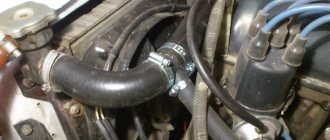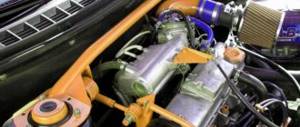Friends, I think this topic is interesting for many and the result of our joint constructive discussion will be useful.
INTRODUCTION:
There are coolant heaters, heating in which is carried out by special glow plugs (not to be confused with the usual ones for gasoline engines. Structurally, there are 2, 3 and 4 plugs. Each such spark plug carries a current of 10 to 15 Amps.
THIS IS NOT A PRE-STARTING HEATER. THIS IS A COOLANT HEATER, WHICH IS ALREADY TURNED ON WHEN THE ENGINE IS RUNNING.
Let's agree right away
1. Such products have long been standardly installed by automakers on many diesel and other car models. So let’s skip the phrases “collective farm”, “how are you going to heat the antifreeze with candles” and the like. 2. Comments on the case, constructive, with catalog numbers, with links to examples of installation in real cars, and I ask you - let’s do without the empty phrases “wow, that’s not necessary”, “everything warms up quickly for me”, “you’ll have a battery” change once a year” and the like. I am also surprised by my comrades who give advice to set the thermostat to 92C to warm up the car faster. Gentlemen - the thermostat does not contribute to faster warming up of the engine and coolant, it only increases the threshold temperature for the transition from a small circle of operation of the cooling system to a large one through the main radiator.
So there you go! There is a task - to achieve faster heating of the coolant in the stove.
Personally, my input data is 1.
I drive 40 km a day (so that the generator has time to charge the battery),
2.
no 220V heaters - it’s inconvenient (depending on the outlet) and unsafe (dubious quality of components of more dubious origin)
3.
I agree that this there was not a pre-heater, but a heater after the engine was started
4.
only factory products (heater housing, flanges, gaskets, spark plugs)
5.
surely the introduction of such a unit will lead to faster aging of the coolant, but I’m ready to change the coolant not after 5 years/75tkm , and even twice as often.
6.
I think heaters with more than 2 candles will be redundant.
7.
Installation under the hood, not in the cabin
HEATER OPTIONS
this is what I found on Drive and more
To prevent the antifreeze in your car from freezing during the cold season, you can use preheating. A description of this device earlier ; it was made using homemade heating elements, the voltage is 12 Volts. However, it is possible to make a more powerful and faster device with your own hands that will heat the antifreeze and protect it from freezing.
In this case, instead of heating elements, glow plugs will be used, preferably from a foreign car, designed for a voltage of 11.5 Volts. Three spark plugs need to be installed in the heat exchanger, in its body. You can buy the simplest candles, for example: 2 pieces SWAG10919223 and 1 piece NipponDenso DG010.
The spark plugs are connected as follows
– two spark plugs are connected together with their pluses using a jumper;
– the remaining spark plug is connected separately.
With this connection, it will be possible to use different degrees of heating: on one candle, on two candles or on all three candles (in severe frost).
To connect candles, you can use automatic machines that are placed in electrical panels (220 Volts).
To connect one candle, you need to use a double wire (each 1.5 sq. mm) and a 16 Ampere circuit breaker. To connect two spark plugs, the thickness of the wires should be 2.5 square meters. mm, and the machine should be 25 Ampere. Also double wire of 2.5 sq. mm. used to connect both machines and ground. The circuit breakers used will perform the functions of both a switch and a fuse.
Electric pre-heaters
Using such devices, you can heat the liquid and motor in 10-20 minutes. The best models are presented further in the rating.
Severs+ with pump 2 kW outputs 20 mm
This is a model from a domestic manufacturer - . It produces heaters under the Severs brand. The presented device belongs to a new generation and is additionally equipped with a pump. The new design allows the liquid to be heated quickly and evenly. The model is suitable for passenger cars and trucks. The device has a thermostat, high temperature protection and a daily timer. In addition, the model is easy to install and is comfortable and safe. A 24 month manufacturer's warranty is provided.
Advantages:
- excellent security;
- easy to install thanks to detailed instructions;
- there is a thermostat;
- versatility, suitable for any car.
Flaws:
- not identified.
Customer Reviews
Alexander Ordered at the end of 2020. and if it weren’t for the holidays, I would have received it before the new year. We quickly contacted, clarified, advised and sent without delay. The heater was packaged well, almost everything was included (I bought an additional 1 meter of hose), installed it in 2 hours. The device works at 100%. It's a pleasure to deal with such people. Thank you!
Andrey I bought a Severs with a 2 kW pump in the fall (an old model, it seems to have 14mm outputs), it works properly. I installed it instead of the usual Severs, which is connected to the engine. There is no need to look for an installation kit separately, and installation was less hassle (at least for me). I was pleased with the product. Take it - you won't regret it.
Sputnik 1.5 kW KM-0001 for VAZ-2101-2107 carburetor
This heater is well suited for passenger cars or minibuses. It is easy to install it yourself, since the integration scheme is well described in the instructions. There is a forced circulation system, thanks to which the antifreeze temperature will always be positive even in severe frost. Users note that the device effectively performs its function. There is protection against overheating, automatic shutdown of the device and partial heating of the interior. The model is quickly installed and requires almost no maintenance.
Advantages:
- quick warm-up of the engine;
- can partially heat the interior;
- ease of operation.
Flaws:
- high price;
- rigid cable, becomes brittle in cold weather.
Customer Reviews
Vitaly Ordered it, it was sent quickly, it installed very quickly, it has been working for a week now. At a temperature of -15, it heats the engine up to 40 ° per hour, consumption 1.5 kW/h. The car starts like it was in summer, a very useful device.
Pavel I would say that this is a cheaper and simplified version of Severs. Almost twice the price of its “brother”, but it works fine. So far I'm happy with everything, I installed everything according to the instructions, it works well, but time will tell.
Spark plug power indicators
- it is known that one candle requires 15.5 Amperes to consume. This means that if the voltage is 12 Volts, the power of one candle will be 186 Watts;
- the power of two candles at the same voltage will be 372 Watts;
- the power of three candles is 558 watts.
It is worth remembering that during the warming up process, the power may decrease by one Ampere. In the last photo you can see thin wires. They will be needed to connect two LEDs. These wires are connected to the ground of the heater, to the negatives of the LEDs of the machines. The LEDs themselves will be connected to the output of the machines through a precise resistance, namely 2 Kom. In this way visual control is achieved. It is recommended to insulate the heater itself so that the heat generated is directed to heating the antifreeze, and not the street.
The best liquid pre-heaters for a gasoline engine
Gasoline engines are characterized by rapid warm-up, so pre-heaters are installed on cars with large engine capacity (2.0-4.0 l). The advantages include autonomy and heating efficiency. The obvious disadvantage is the high price and complex installation. The experts selected several high-quality models.
HYDRONIC B5W S
Hydronic B5W S 12V is recommended for installation and operation in vehicles with an engine capacity of 2-4 liters.
HYDRONIC B5W S
The petrol version has a maximum heating output of 5 kW at the start of the engine warm-up cycle. During operation, the power of the engine heater is reduced to 1.5 kW, which leads to a decrease in fuel consumption and battery charge.
WEBASTO THERMO TOP EVO 5 GASOLINE
Pre-heaters from the German company WEBASTO are so popular among motorists that the name of the company has become a household name. If the car is equipped with Webasta, it is not afraid of winter cold. The WEBASTO THERMO TOP EVO 5 model, created for installation in gasoline cars, finds a wide range of applications. On factory assembly lines, manufacturers of modern cars integrate this heater into cars, minibuses, and SUVs. The main thing is that the volume of the gasoline unit does not exceed 4 liters. Experts note the versatility of the launch. This can be done from the key fob, through a smartphone application, or configured to turn on using a timer.
This is interesting: What to do and what the fine is if the license plate light does not light up
The heater deservedly wins our rating. Users are satisfied with the device’s performance, unpretentiousness and durability.
EBERSPACHER HYDRONIC B5W S
There are also petrol versions from the well-known manufacturer of preheaters EBERSPACHER. The HYDRONIC B5W S model is designed for installation in vehicles with a voltage of 12 V. The power of the device (5 kW) is enough to warm up cars, vans and SUVs with engines of 2.0-2.4 liters. Experts recommend the heater for regions with temperate climates. Only a mounting kit is supplied with the device; controls will have to be purchased separately. The device consumes from 0.2 to 0.69 liters of gasoline per hour.
The heater takes second place in the rating for reliability and durability. Motorists note the ease of operation and maintainability. The disadvantages include modest equipment and a high price.
Installing an antifreeze heater
- installation location – lower pipe (located in the heater radiator);
- When installing the heater itself, it is advisable to also install a pump (12 Volt), which will make the device operate more efficiently.
An additional pump is also installed in the lower pipe. True, in this case there will be a need for additional pipes, for example 16 mm. Such pipes can be taken from the VAZ-2106 stove.
The frame of the device is made of a pipe 1 mm thick. The housing must be soldered using copper solder and a gas torch; instead of a torch, you can also use a welding machine.
The result is a device similar to an expansion flow tank into which spark plugs will be inserted (precisely those three glow plugs that were described above).
The candles are attached using fum tape, sealant - either auto or threaded.
The device is ready! All you have to do is install it on the car. It is not necessary to heat it to a high temperature; zero degrees will be enough. This temperature is just enough to start the car engine. When the engine is already running, you don’t have to turn off the heater. While the engine is running, you just need to turn off the spark plugs one by one, thereby reducing the heat.
We also recommend that you familiarize yourself with the methods of warming the engine and heating the steering wheel , and the car interior in general.
Good luck on the roads.
Author: Vinogradov Victor. Ufa
NECESSARILY .
Making your own heating
Connecting the heater to the engine
You can do it yourself in several ways to warm up the engine. One of the ways to make heating with your own hands is the method described below. When making any homemade device for a car, you need to be extremely careful when using it in the future - this is important.
There have always been plenty of craftsmen in Rus', and for the most part, engine heating can be made from a variety of materials. It can be either heating from a blowtorch, heaters based on a spiral, or from wire, as many minds as there are as many options. The only but significant drawback of such devices is their fire hazard, so this must be taken into account when manufacturing them.
So, it's worth considering one of the DIY heaters made from a 12mm gun casing, a glow plug, a relay and copper wires. The peculiarity of this method is that it serves as a preheater not for the engine as such, but for the fuel, which in turn allows you to start the engine in the cold season without any problems.
To make the heating itself, first in the sleeve, in its side wall and in the bottom, you need to make a hole in which the thread for the candle will be cut. After this, the sleeve should be screwed to the suction pipe, after which the entire structure is installed in the car tank, and a wire with on-board network voltage, that is, 12 volts, is connected to it.
This type of heating can only be used when the engine is turned off, otherwise a breakdown may occur, which will take a long and expensive time to fix. Therefore, it is worth noting once again that it is best to spend some money and buy a factory heating unit, for the safe operation of which the car owner will be calm.
The idea of heating antifreeze for a diesel car: basic provisions and nuances
The essence of the solution
Modern diesel engines are distinguished by the fact that they use heating of antifreeze with glow plugs in a certain temperature range. The main goal is to extend the life of the particulate filter. When cold, the fuel does not burn completely and soot is formed, which settles on the honeycomb of the filter element. As it warms up, its concentration in the exhaust gases decreases.
Structurally, the idea is presented in the form of a metal block into which special glow plugs are screwed. The housing is a component of the cooling system - a “coolant” circulates through its internal cavity. Most often, the assembly unit is integrated into the cylinder head.
The spark plugs are not always active: the ECU specifies a maximum coolant temperature below which the heater starts working. The system operates in fully automatic mode - when the upper thermal limit (60-75°C) is reached, the heater is deactivated.
Requirements
Let’s say right away that the installation should not be regarded as pre-heating of the coolant. This is not Webasto or Eberspächer! The device operates exclusively when the engine is running - the liquid must circulate through the internal channel.
Based on the operating features of the factory coolant heater, you can create a list of requirements that must be met when assembling and installing a home-made product:
- Switching on should occur after starting the engine.
- Automatic control is carried out by a temperature sensor, which opens the power circuit when it reaches 60-75°C and supplies current to the spark plugs at temperatures below 60-75°C.
- Duplicate manual channel for selecting the operating mode.
Homemade car engine preheater
When cold weather sets in, the car engine starts under more extreme conditions: the engine oil becomes thick and the fuel evaporates poorly. It is more difficult for the starter to turn the crankshaft, compared to the summer period of operation of the car.
In turn, this causes large discharge currents in the battery. If the battery is discharged or worn out, the engine may not start. It's unpleasant, isn't it?
To make it easier to start the engine at low air temperatures, engine pre-heaters have appeared. They can be roughly divided into several categories: operating autonomously using heat from the combustion of liquid or gaseous fuel, and also using thermal energy released from the flow of electric current in a conductor with increased resistivity.
The purpose of an engine preheater is to heat the engine itself by warming up the coolant. They are also called car antifreeze heaters. In this article we will look at a 220 volt electric engine preheater.
Electric engine heater device
The design of an engine preheater with an electric heating element is very simple. It consists of a cavity body in which a 220 V electric heater and a thermostat are installed. Two tubes are mounted into the cavity of the heater body, an antifreeze supply and a pipe for discharging heated antifreeze into the engine cooling jacket.
Some types of 220 volt engine preheaters are paired with a pump. The pump forcibly accelerates the heated coolant through the engine jacket, thereby providing better warm-up.
Power and cost of preheaters
The power of modern electric preheaters ranges from 1 to 2 kW. The price of a 220 volt engine preheater ranges from 1000 to 4000 rubles.
Installing a 220 volt engine preheater on a car
This article discusses the installation of an Audi 80 engine pre-heater. Such an engine heater was purchased at a car shop.
In its kit it has two pieces of rubber pipe, hose clamps, several different fittings, an electric heater mounting bracket with bolts and nuts. The power of the heating element is 1.5 kW, which is quite enough to heat the engine to 50-60 degrees for 1 hour at a frost of -40 Celsius.
For installation, we first need to determine the insertion location of the heater. On an Audi 80 with a four-cylinder engine, the optimal place for inserting the electric heater is the S-shaped hose connecting the pump inlet and the upper engine pipe. It needs to be cut approximately in the middle into two parts. I did a simpler thing - I bought a new hose of a similar shape and cut it. I put the old one in reserve, so to speak.
Next, we need to make an adapter-fitting in advance from the fitting included in the kit for connecting the hoses in this place. I took the fittings from the kit and went to a turner I knew and showed me that I needed to connect two hoses using a ready-made fitting. In short, he turned out two small squeegees with a brush. The finished fittings were inserted into the manufactured fittings and sealed by welding. Unfortunately I don't have any photos left.
And so the adapters are ready, all that remains is to install the heater. To do this, drain the antifreeze from the Audi 80 engine, release the clamps on the S-shaped hose and remove the latter from the lower and upper pipes. We determine the installation location of the heater. In my case, I attached it to the mounting ear of the left engine mount. I used the standard mounting bracket that came with the kit and an additional homemade one from a piece of corner.
The heating boiler is installed, now we begin to supply pipes to it. We fix the sections of rubber pipes on the upper tee from the temperature sensor and pump with new clamps. We insert homemade fitting adapters into the ends of the pipes and also clamp them with clamps.
We fix the pipes on the heater with clamps, and after cutting off the extra pieces of the rubber pipe from the kit, we put them on homemade adapters and also don’t forget to secure them with screw clamps.
We pour antifreeze back into the Audi 80 engine cooling system. Start the engine and warm it up to operating temperature, not forgetting to monitor the condition of the connections on the electric heater and the engine. If nothing leaks, then you can congratulate yourself on successfully installing an electric heater on an Audi 80 with your own hands.
After installing the engine heating electric boiler, do not forget to check its operation by connecting it to the network. If there are no air pockets in the cavity, then immediately when you feel the pipes, circulation of heated antifreeze should appear through the engine cooling jacket.
Do-it-yourself homemade pre-start electric engine heater for 220 volts
This is an option for those who are limited in funds and have a lot of free time or like to do everything with their own hands. To make a homemade engine heater we will need: - a 40mm piece of water pipe - a heating element with a built-in thermostat - two 15mm bends a nut for the heating element block a steel sheet 3-4 mm thick, size 50 * 50mm
First of all, we go to the store and buy a heating element unit with a built-in thermostat. It costs little money. About 400-500 rubles for 1.5 kW. Next, we need to order a nut from a turner to screw in this block. Next, we take a piece of pipe 40 mm long, slightly larger than the length of the heating element, and weld a nut on one side, and tightly weld it on the other side with a steel plate. Using welding, we burn two holes in the pipe and weld two 15mm bends. Later we will put hose pipes from the engine on them.
Homemade heating of antifreeze in the cooling system with glow plugs: design basics
The main structural elements of the heater are the block and spark plugs. The electrical part consists of large cross-section wires, a thermal relay (thermal sensor), a fuse and an electric relay designed for high current. The main difficulties are associated with the manufacture of the housing to accommodate the heaters.
Components
When designing antifreeze heating for a diesel engine with your own hands, you should pay special attention to the number of spark plugs: two or three heaters are quite enough. An excessive increase in the number of heat-generating components is fraught - each candle has a power of about 200-250 W and consumes considerable current.
Branded heater housings are available both at disassembly sites and in retail sales. One of the options is VAG 028 121 145B for three spark plugs. Price – about 2,000 rubles. In addition to this product, it is recommended to purchase sealing rubber VAG 037 121 687. An alternative is to look at disassembly sites:
- JP GROUP 114505200.
- TRICLO 463201.
- Vaico V10-0962.
- MALO 116092.
- Renault 8200012119.
- Hyundai/Kia 97341-26100.
Fitting
The VAG block is focused on one-way communication. Installing a plastic counter flange will help correct this issue. Its catalog number is VAG 026 121 144E. The cost is about 500 rubles. Alternative parts:
- VIKA 14253 (metal – 250 rubles).
- DELLO 301210144026E (plastic – 50 rubles).
- VAICO V100270 (plastic – 80 rubles).
- JP GROUP 1114500600 (plastic - 50 rubles).
- VAG 0261211452 (metal - 750 rubles).
Total
Homemade antifreeze heating for a diesel car aims to speed up the warming up of the engine and interior. The essence of its work is that glow plugs heat the coolant when the engine is turned on in a certain temperature range. The installation is easy to assemble yourself using components from VAG.
The heater fits into the inlet of the cabin radiator, the temperature sensor into the outlet of the heater. There are no special comments regarding the installation of performing equipment. Regarding the electrical wiring connection, the only warning is not to mix up the 30A and 70A relays.
Other electric heaters
On the market you can buy boilers for heating the engine of other well-known brands, for example:
- Start-M;
- Severs-M.
How do these electric boilers work?
When the device is connected to a 220V outlet, the coolant is heated in its body and with the help of a valve, due to the pressure difference, a directed circulation of antifreeze (antifreeze) is obtained through the heating and cooling system of the vehicle.
Heater device
And the thermostat is designed to prevent overheating of the device itself and the cooling liquid.
How to install heating with your own hands?
The purchased kit includes an installation manual that will help you install the pre-start electric boiler yourself.
All instructions are different depending on the device model, but the installation principle is usually as follows:
- drain the coolant;
- attach the electrical device to the cylinder block;
- instead of a temperature sensor, install a tee fitting and screw the temperature sensor into it, and install an outlet for the hose through which the heated liquid will flow;
- instead of a drain plug (faucet) on the cylinder block, install an outlet for a hose for cold liquid, which will go into the heating;
- tighten the clamps on the hoses;
- pour antifreeze (antifreeze).
Useful video, heating the 220V engine, operating principle and installation on a VAZ 2110:
Methods for heating a diesel engine in winter and what type of heater to choose?
There are good equipment on the market for heating a diesel engine in winter. Mainly produced are types of electric heaters that operate from the car's network to heat the fuel system of a diesel engine.
What types are there?:
- heaters for fine filters, installed inside the filter;
- flow heaters, mounted in the fuel line;
- bandage heaters, put on the filter housing;
- posistor-type heaters are installed in the fuel intake in the fuel tank;
- Autonomous engine heaters (liquid), mounted in any car.
Watch the video, heated filter separator:
Video review of Nomakon diesel fuel heaters:
When choosing a heater, I recommend paying attention to the engine design and parking conditions. Autonomous heaters require a supply of fuel in the tank and excellent condition of the battery. Storage heaters are beneficial for frequent use.
Pay attention to electric heaters from a 220V network. The electric option is advantageous for a diesel engine. They are inexpensive. They are especially relevant in cases where the car is located in a garage or at home.
Severs, Electrostart or Defa models to save your budget .











